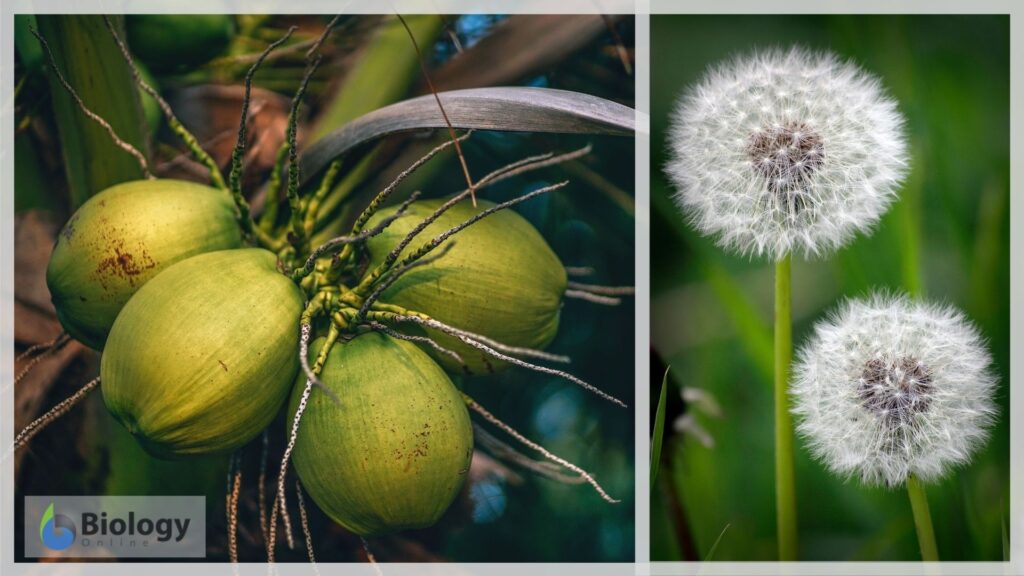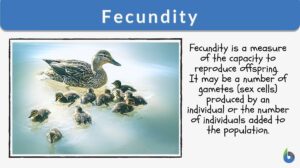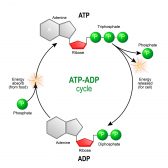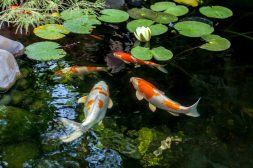
Fecundity
n., plural: fecundities
[fɪˈkʌndɪtɪ]
A measure of the capacity to reproduce offspring
Table of Contents
Fecundity Definition
The meaning of fecundity is the reproductive rate (fecundity rate) or the performance of an individual or the population. In biology, what is the meaning of fecundity? Fecundity is the estimate of the number of gametes produced by an individual. In simpler terms, fecundity is the quantification of the number of individuals added to the population.
In biology, fecundity is a measure of fertility. It may also pertain to the ability to produce offspring or to cause growth. In demography, it may be measured by counting the gametes, seed set, or asexual propagules. Etymology: from Latin fēcunditās , meaning “fertility”.
Demographically, what is fecundity? Demographers have a different way to express this. They define fecundity as (1) the possibility of becoming pregnant or (2) the likelihood of exposure to being pregnant, which is essentially dependent on the sexual pattern and preventive measures being taken. In humans, the fecundity is reflective of the duration between female menarche and menopause.
Fecundity is influenced by the accessibility to the resources and access to possible mates. Thus, fecundability is the ability of a female to produce progeny in a given reproductive cycle.
A contrasting term to fecundity is reproductivity (synonyms: reproductive output; reproductive potential; fertility), which represents the number of individuals or the proportion of the population that was deducted or died from the population in a specified period of time.
Fecundity vs. Fertility
Fecundity is often confused with fertility and vice versa, however, these terms are completely different. So, what is the difference between fecundity and fertility?
Fecundity is the capability of an individual or population to produce offspring whereas fertility is the number of offspring produced by the population or the individual. Fertility is the actual number of offspring produced and not the rate of reproduction. The individual capable of reproducing is known as fertile.
Fecundity is the natural ability of a person to reproduce and that depends on the health and availability of healthy and genetics. On the other hand, fertility is the number of offspring per couple in a population.
Fertility is dependent on various factors, such as lifestyle, stress, emotional and reproductive health, willingness, availability of a potential mating partner, and preventive measures being taken.
Fecundity is not equivalent to fertility as the translation of the ability to reproduce is further dependent on a number of societal, environmental, and physiological factors.
Complete or 100% translation of fecundity into fertility is seldom possible in any given population whether they may be of animal or plant.
Fecundity is a developmental and genetic trait that advances within a specific framework.
| Table 1: Fecundity vs. Fertility | |
|---|---|
| Fecundity | Fertility |
| Biological capacity or physical ability to reproduce offspring | The actual giving birth of mothers or the number of offspring produced by the population or the individual |
| Starts at first menstruation or menarche (or puberty) | Starts at sexual intercourse |
| Chiefly cannot be modified | Can be modified |
| Dependent on various factors, e.g. societal, environmental, genetics, health, and physiological factors | Dependent on various factors, e.g. lifestyle, stress, emotional and reproductive health, willingness, availability of a potential mating partner, and preventive measures being taken. |
Methods to Estimate Fecundity
The method to measure fecundity varies as per species and their mode of reproduction as well.
Fecundity is usually measured as the number of litters in a year for viviparous organisms, like placental mammals. Fecundity measurements in oviparous animals are typically carried out by directly counting the eggs in nests or oviposition sites.
In aquatic animals (except mammals and reptiles), the count of oocytes from a spawning female is used to measure fecundity. In highly fecund spawners, to measure fecundity, the fraction of ovarian tissue of known weight/volume and the consequential oocyte densities are extrapolated to the total weight/volume of the ovary using a gravimetric or volumetric method. The size of oocytes is also employed to measure fecundity.
The day-specific probabilities of conception with respect to the day of ovulation along with the assessment of time to pregnancy are taken into account to measure fecundity in humans.
Fecundity in Ecology and Biological Importance
In ecological terms, the net reproductive rate is an important parameter that takes into account fecundity. Net reproductive rate is the average number of offspring that a female can produce throughout its reproductive life span, with due consideration of fertility with respect to age and rate of death in a given period of time.
1. Energy investment
An estimate of population fecundity improves the ability to translate research in reproductive physiology into foreseen effects on fertility. Thus, fecundity is a very important parameter to study in ecology and animal biology. In ecology, fecundity is also an indication of the amount of energy that is spent on raising offspring.
As a general rule of thumb, fecundity is inversely proportional to the amount of energy spent. Let’s understand it more simply, the higher the fecundity i.e. higher the ability to reproduce, the lower would be the requirement of energy to be spent on raising offspring i.e., parental care.
As per this rule, there are two possibilities: (1) a group of the population that can reproduce in higher numbers and (2) a group of the population that can reproduce a limited or few offspring in their lifetime. Thus, as per the inverse fecundity and energy rule:
- A relatively small energy investment is required by the organisms that can produce large numbers of offspring. In terms of parental care, most of the offspring are capable of taking care of their own from a very early stage and do not need much parental intervention for their development. In such a scenario, the “survival of the fittest” theory comes into play, and energy investment by the parents for the survival of their offspring is very low. A typical example of this can be seen in marine ecology. Sea urchins, sea snails, or even most of the fishes lay hundreds of eggs. A sea urchin can lay 100,000,000 eggs in one cycle!! These animals are not invested in the survival of each offspring they reproduce.
- Large energy investment in each offspring along with huge parental intervention is required by the organisms that can produce few offspring and are heavily invested in the survival of each. Here, parents invest a lot of energy to ensure the survival of their offspring. Most mammals, including humans. fall in this category. Panda is one such animal with low fecundity and can reproduce a single offspring in one reproductive cycle. The offspring is completely helpless at the time of birth and is completely dependent on their mother for their developmental needs. Such animals invest a huge amount of energy in the development, care, and protection of their offspring till the time their offspring become independent.
This inverse fecundity and energy rule are similarly applicable to the Plant Kingdom as well. Here, of course, the energy investment is not in terms of parental care, however, it is in terms of energy-rich quality seeds.
Plants with low fecundity will produce a few or limited numbers of seeds with high energy which thereby have the higher or maximum possibility of survival, for example, coconuts. On the other hand, plants with higher fecundity will produce a large number of seeds (e.g. dandelion) but each seed will have a low amount of energy. Thus, the survival chances of these seeds would therefore be low.

2. Reproduction time
Another important aspect of fecundity and ecology is the time of reproduction. Again, the population can be divided into two basic groups depending on the time when an organism starts to reproduce:
- Early reproducer: the organism/individual that starts reproducing at an early age usually does not grow in size as their maximum energy is utilized in the process of reproduction. However, these organisms are at the least risk of not having any progeny. Such organisms generally have a shorter life span. Examples are small fishes, like guppies.
- Late reproducer: the organism/individual that starts reproducing relatively at a late age usually has higher fecundity and a longer life span. Examples are sharks, bluegill, etc.
3. Parity
Parity is indicative of the number of any individual that can reproduce in its life span. Some organisms can reproduce their progeny only once in their lifetime while others can exhibit multiple reproductions. Thus, fecundity can follow two patterns:
- Semelparity: an organism or individual is described as semelparous when it reproduces only once in its life span. Such organisms utilize all their energy to reproduce and then eventually die, once they reproduce. Examples include certain bacteria, bamboo trees, and chinook salmon. The time to reproduce varies in different organisms, some may start reproducing within half an hour or so (e.g., certain bacteria) or within a year or in certain animals after years of attaining reproductive maturity. However, in all the cases the individual dies off post-reproduction. Two marsupial families, such as Didelphidae and Dasyuridae, exhibit semelparity. In certain semelparous species, after a highly synchronous mating season, the male member of the population dies off. It is presumed that intense male-male competition induced due to monoestrous reproductive pattern, high estrus synchrony, and a short mating season, has led to the evolution of low survival of male semelparity. In addition to this, in some species, a long lactation period results in high female mortality thereby exhibiting female semelparity.
- Iteroparity: an organism or individual that reproduces multiple times throughout their lifetime. Humans and primates fall under this category. These species can reproduce multiple times throughout their reproductive life span. However, reproductivity starts post-reproductive system maturation. The age or duration to reach reproductive maturity varies from species to species (from days to years). Further iteroparity can be classified as (depending on the reproduction frequency)-
- Daily– e.g. some tapeworms
- Semi-annually/ Annually/Biennially: Certain iteroparous organisms produce offspring only in alternate years. Thus, a significant duration of their reproductive life span is not utilized. This phenomenon is known as ‘low frequency of reproduction’. E.g: willow tits (Parus montanus), fat dormice (Myoxus glis) and kittiwakes (Rissa tridactyla), etc. The low frequency of reproduction is presumed to be an ecological phenomenon to raise the average fecundity.
- Irregularly– e.g. Humans
In iteroparity, the fecundity increases with age and then eventually decreases. Thus, the organism stops growing once they reach reproductive maturity and are ready for their first progeny production. This is to conserve all their energy to invest in the process of reproduction. This is a kind of ecological pattern to increase fecundity. This concept led to the coining of the term’ primiparity’ which is the age of first reproduction. Ecologically, if an individual/organism does not stop growing in its reproductive age, then there is a high probability of a low survival rate of the progeny. Both the parent as well as the progeny would not be physically competent to withstand the environmental pressure i.e., the survival of the fittest. Thus, unfit or incompetent organisms or individuals would be eliminated from the system.
Factors affecting Fecundity
Some of the factors affecting fecundity are explained below. These factors include body size, environmental conditions, are choice of a mating partner.
Allometric scaling or effect of body size on fecundity
Metabolic rate, dispersal capacity, survival probability, and fecundity are some of the factors that cause the disparity in body mass among individuals or species. However, it is important to understand that in a species, the ratio of combined offspring mass to maternal mass tends to roughly remain constant. This means that females with larger bodies tend to have higher fecundity and larger offspring. Thus, evolutionarily, a larger body gives a selective advantage to large-sized females and their offspring.
Effect of environmental conditions on fecundity
The fecundity is affected by environmental conditions. Environmental conditions can affect maternal body condition and survival. Thus, affecting the fecundity.
Choice of the mating partner
The theory of mate selection is based on the fact that a female may select a superior mating partner in order to increase the fecundity. The selection of a superior mating partner is linked to producing genetically healthy and better-quality offspring with high fecundity. Certain species are involved in multiple mating. This is again linked to selecting a superior mating partner.
Nevertheless, multiple mating can be huge energy investing activity for females. Multiple mating results in the improvement of fecundity due to the fact that egg production is stimulated by mating, fresh sperms help to maintain the fertility of eggs, egg production rate also increases with the mating.
Multiple mating results in sperm-sperm competition. Two sperms compete to fuse with the ova. Again, by the theory of survival of the fittest, the sperm that apparently is superior will eventually fuse with the ova. This results in the formation of a zygote likely with a viable genetic constitution. Males usually have higher fecundity than females.
Biological and Ecological Significance of Fecundity Measurements
Fecundity is an essential component of studying the population composition model. To understand the life history strategy and the factors affecting the, it is equally important to study population fecundity, fertility, and survival rate.
Different models are employed to study their cumulative effect on the life history strategy of a population. One such model is the stage-structured matrix population model. This model mathematically summarizes the population behavior using stage-specific estimates of vital rates (rates of birth, growth, maturation, fertility, and mortality) and it gives a relationship between the individual (and its selective pressures) and the population. This model gives a stable stage distribution which gives an estimate of the theoretical population composition that exhibits a fixed birth rate. Thus, the factors like the variation in the environment or any other intrinsic regulatory factor that change the theoretical population composition can be graded to study and predict their effect on the composition of the population.
This model also gives the contribution of an individual to the future status of its population by taking into account fecundity, fertility, and survival rate. This is known as the reproductive value which essentially is the sum of the current and future reproductive values.
By nature’s selection theory, reproductive value is the currency used by nature to generate a specific life-history approach. By natural law, reproductivity is to be maximized, thus the population model takes fecundity into account.
While in matrix models, the changes in fertility (and survival) to population growth give a stage-specific sensitivity analysis. In this model, the reproductive value at a particular stage is calculated as the product of the sensitivity of all matrix elements that contain that stage and the stable stage proportion. Thus, a short-lived species has a tendency to exhibit higher fertility sensitivity than for survival. While the long-lived animals exhibit higher sensitivity towards survival than fertility. Thus, the factors that affect the population composition can be studied.
Try to answer the quiz below to check what you have learned so far about fecundity.
References
- Källén, B. (1988). Epidemiology of human reproduction. Boca Raton, Fla: CRC Press.
- McMahon, R., and Bradshaw, C. J. A. (2008). Fecundity. In: Jørgensen, S. E., Fath, B. D. (Eds), Population Dynamics. Encyclopedia of Ecology, Oxford: Elsevier. Vol (2) pp.1535-1543.
- Ganias, K. (2018). Fecundity. Vonk, J., Shackelford, T.K. (eds.) In: Encyclopedia of Animal Cognition and Behavior. Springer International Publishing. Pp 1-4. doi.org/10.1007/978-3-319-47829-6_221-1.
- Stearns, S. C. (1992). The evolution of life histories. New York: Oxford University Press.
- Shine R (1988) The evolution of large body size in females: A critique of Darwin’s ‘fecundity advantage’ model. American Naturalist 131: 124–131.
- U.N. Asian Development Institute Bangkok. (2003). A Glossary of Some Terms in Demography. Bangkok, Thailand: Abhinav Publications.
- Wood J. W. (1989). Fecundity and natural fertility in humans. Oxford reviews of reproductive biology, 11, 61–109.
©BiologyOnline. Content provided and moderated by BiologyOnline Editors.








